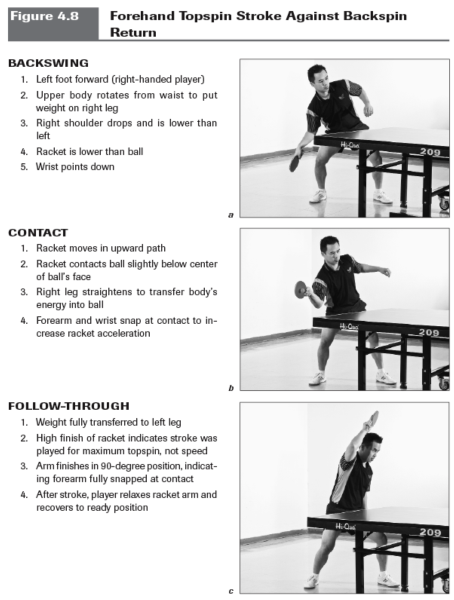Topspin Strokes
The development of the topspin strokes closely parallels the development of the modern attacking game. The first use of a heavy topspin stroke came about as an effort to find a safe way to attack the backspin in defensive play, which was popular in the 1950s and early 1960s. By starting the stroke low and brushing almost straight up, it became possible to send a strong topspin return that went high over the net and violently kicked forward and downward after hitting the table. This made life very difficult for the chopping defender.
The high, looping trajectory of these early topspin strokes led to their often being called loops. As the years went by, players learned how to execute strong topspins against topspin returns (counterspins) as well. In today’s game, topspin strokes and counterspins are the most-used strokes in the game. As discussed in step 3, topspin allows a player to hit the ball with great speed and still have it curve back down on the table.
Three Basic Elements for the Topspin Stroke Against Backspin
How to touch the ball = if a slow loop, with maximum friction; if a fast loop, with mixed friction and force contact
When to touch the ball = for maximum topspin, as the ball is descending; for fast topspin, at the top of the bounce
Where to touch the ball = if a slow loop, toward the bottom of the ball; if a fast loop, slightly below the center of the ball
When playing topspin strokes, you can contact the ball at several points along its path to produce varying amounts of spin and speed. For maximum spin, contact the ball as it descends. For fast topspin, play the ball at the top of the bounce.

Forehand Topspin Against Backspin
The forehand topspin is the easiest topspin stroke for a beginner to learn. The backspin return travels slowly, so you have more time to execute the stroke. Because you are adding to the spin on your opponent’s return, you can produce the most topspin with this stroke.
When first learning this stroke, try to send the ball high over the net and create as much spin as you can. Adding speed to this stroke is easy. Developing the hand skills necessary for transferring all your energy into the ball as spin is the hard part to learn.
From the ready position with your left foot forward (if you are a right-handed player), bring the racket below the ball and slightly back (figure 4.8a). Rotate your hips and shoulders to the right and transfer your weight onto your right leg. The wrist points downward.
